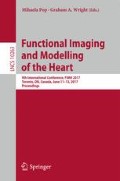Abstract
Computer models of the heart are of increasing interest for clinical applications due to their discriminative and predictive abilities. However the number of simulation parameters in these models can be high and expert knowledge is required to properly design studies involving these models, and analyse the results. In particular it is important to know how the parameters vary in various clinical or physiological settings. In this paper we build a data-driven model of cardiovascular parameter evolution during digestion, from a clinical study involving more than 80 patients. We first present a method for longitudinal parameter estimation in 3D cardiac models, which we apply to 21 patient-specific hearts geometries at two instants of the study, for 6 parameters (two fixed and four time-varying parameters). From these personalised hearts, we then extract and validate a law which links the changes of cardiac output and heart rate under constant arterial pressure to the evolution of these parameters, thus enabling the fast simulation of hearts during digestion for future patients.
Access this chapter
Tax calculation will be finalised at checkout
Purchases are for personal use only
References
Laughlin, M.H.: Cardiovascular response to exercise. Am. J. Physiol. 277(6 Pt 2), S244–S259 (1999)
Chabiniok, R., et al.: Multiphysics and multiscale modelling, data-model fusion and integration of organ physiology in the clinic: ventricular cardiac mechanics. Interface Focus 6(2), 20150083 (2016)
Hauser, J.A., et al.: Comprehensive assessment of the global and regional vascular responses to food ingestion in humans using novel rapid MRI. Am. J. Physiol. Regul. Integr. Comp. Physiol. 310(6), R541–R545 (2016)
Otsuki, T., et al.: Contribution of systemic arterial compliance and systemic vascular resistance to effective arterial elastance changes during exercise in humans. Acta physiologica 188(1), 15–20 (2006)
Albert, R.E., et al.: The response of the peripheral venous pressure to exercise in congestive heart failure. Am. Heart J. 43(3), 395–400 (1952)
Molléro, R., et al.: Propagation of myocardial fibre architecture uncertainty on electromechanical model parameter estimation: a case study. In: van Assen, H., Bovendeerd, P., Delhaas, T. (eds.) FIMH 2015. LNCS, vol. 9126, pp. 448–456. Springer, Cham (2015). doi:10.1007/978-3-319-20309-6_51
Westerhof, N., et al.: The arterial windkessel. Med. Biol. Eng. Comput. 47(2), 131–141 (2009)
Sermesant, M., Konukog̃lu, E., Delingette, H., Coudière, Y., Chinchapatnam, P., Rhode, K.S., Razavi, R., Ayache, N.: An anisotropic multi-front fast marching method for real-time simulation of cardiac electrophysiology. In: Sachse, F.B., Seemann, G. (eds.) FIMH 2007. LNCS, vol. 4466, pp. 160–169. Springer, Heidelberg (2007). doi:10.1007/978-3-540-72907-5_17
Pernod, E., et al.: A multi-front eikonal model of cardiac electrophysiology for interactive simulation of radio-frequency ablation. Comput. Graph. 35(2), 431–440 (2011)
Chapelle, D., et al.: Energy-preserving muscle tissue model: formulation and compatible discretizations. Int. J. Multiscale Comput. Eng. 10(2), 189–211 (2012)
Marchesseau, S.: Simulation of patient-specific cardiac models for therapy planning. Thesis, Ecole Nationale Supérieure des Mines de Paris (2013)
Mollero, R., Pennec, X., Delingette, H., Ayache, N., Sermesant, M.: A multiscale cardiac model for fast personalisation and exploitation. In: Ourselin, S., Joskowicz, L., Sabuncu, M.R., Unal, G., Wells, W. (eds.) MICCAI 2016. LNCS, vol. 9902, pp. 174–182. Springer, Cham (2016). doi:10.1007/978-3-319-46726-9_21
Peherstorfer, B., et al.: Survey of multifidelity methods in uncertainty propagation, inference, and optimization (2016)
Ackowledgements
This work has been partially funded by the EU FP7-funded project MD-Paedigree (Grant Agreement 600932) and contributes to the objectives of the ERC advanced grant MedYMA (2011-291080).
Author information
Authors and Affiliations
Corresponding author
Editor information
Editors and Affiliations
Rights and permissions
Copyright information
© 2017 Springer International Publishing AG
About this paper
Cite this paper
Mollero, R. et al. (2017). Longitudinal Parameter Estimation in 3D Electromechanical Models: Application to Cardiovascular Changes in Digestion. In: Pop, M., Wright, G. (eds) Functional Imaging and Modelling of the Heart. FIMH 2017. Lecture Notes in Computer Science(), vol 10263. Springer, Cham. https://doi.org/10.1007/978-3-319-59448-4_41
Download citation
DOI: https://doi.org/10.1007/978-3-319-59448-4_41
Published:
Publisher Name: Springer, Cham
Print ISBN: 978-3-319-59447-7
Online ISBN: 978-3-319-59448-4
eBook Packages: Computer ScienceComputer Science (R0)

